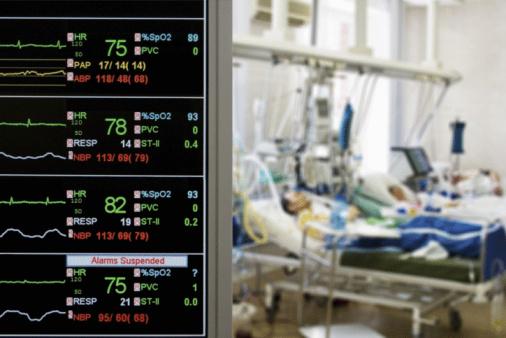Wearing gowns and gloves in all patient rooms in intensive care units (ICUs) didn’t lead to a significant drop in two key antibiotic-resistant threats, but the practice didn’t seem to have any negative effects on patient care, according to a new study.
Though the trial, which covered ICUs in 20 US hospitals in 15 states, didn’t reduce the rates of acquiring methicillin-resistant Staphylococcus aureus (MRSA) or vancomycin-resistant Enterococcus (VRE), researchers did see a slightly lower risk when they looked at MRSA by itself.
The study authors, led by researchers at the University of Maryland, published their findings in an Oct 4 early online edition of the Journal of the American Medical Association (JAMA). The group also reported its findings last week in San Francisco at IDWeek, the annual meeting of four major infectious disease associations.
MRSA and VRE are the primary causes of healthcare-associated infections (HAIs), and though overall HAI levels are slowly decreasing, health officials estimate that the annual price tag for managing the infections is about $4 billion. The US Centers for Disease Control and Prevention (CDC) recommends that healthcare workers wear gowns and gloves when caring for patients who are colonized with MRSA or VRE, but the extra protection isn’t typically worn when the infections haven’t been detected.
The research team wrote that the goal of their study was to determine if having health workers wear gowns and gloves for all interactions with ICU patients could decrease infections from the two drug-resistant organisms without compromising care.
In intervention ICUs, healthcare workers were required to wear gowns and gloves for all patient contact and when entering any patient room. Hospital staff collected MRSA and VRE surveillance cultures on admission and at ICU discharge. The randomized trial tool place from January 2012 to October 2012 and included information on 26,180 ICU patients.
Overall, the rates of MRSA or VRE infections in both the intervention and control ICUs dropped over the study period, but the difference in the change wasn’t statistically significant, according to the study. Researchers did find, however, a borderline statistically significant greater drop in MRSA in the gown-and-glove group. Also, researchers found better hand hygiene compliance on room exit in the intervention group.
Routine gowning and gloving led to fewer healthcare worker visits to the ICU and did not increase the frequency of adverse events such as pressure sores or falls, according to the findings.
Daniel J. Morgan, MD, MS, the study’s senior author and assistant professor of epidemiology and public health at the University of Maryland, said in a press release from the school that infection control studies are needed to advance science and identify measures that can decrease HAIs. “In conjunction with the evolution of hospital cleaning practices, increased hand washing frequency and other measures, patients in hospitals can be safer than they’ve ever been from HAIs.”
The group said their study appears to be the first cluster randomized trial to assess the possible benefits of universal gown and glove use in ICUs, and that earlier, smaller studies suggested benefits.
They wrote that the decrease in MRSA, but not VRE, rates was surprising and requires further study. They suggested that intervention might have different effects on specific antibiotic-resistant bacteria.
Beverly Belton, RN, MSN, a study coauthor from Yale New Haven Health System Center for Healthcare Solutions, said in the press release that it’s prudent to consider universal gowning and gloving in ICUs at highest risk for MRSA infections, regardless of whether patients have been positively cultured.
“Concerns about healthcare personnel acceptance of and compliance with universal gowning and gloving can be overcome with creative efforts focused on early engagement and positive reinforcement,” she said.
In an editorial on the study in the same issue of JAMA, Preeti Malani, MD, an infectious disease specialist from the Department of Internal Medicine at the University of Michigan Health System in Ann Arbor, wrote that even though the well-done trial did not find clear evidence to support the recommendation, several issues deserve careful consideration. She agreed with the researchers that variations in organism biology could lead to differences, but she also pointed out that the difference might reflect possible errors in establishing a VRE baseline.
Earlier studies that explored the impact of universal gowning and gloving on ICUs raised issued about adverse effects, Malani wrote. She added that the new findings requires replication and said that it’s possible that healthcare worker behavior, with an emphasis on ICU safety, could have evolved since the earlier studies.
Lack of harm is one factor to consider in implementing the findings, she wrote. Though the study didn’t find a clear-cut benefit for both organisms, the strategy might be worth considering in some settings, such as when MRSA transmission is prevalent in high-risk areas such as surgical ICUs that have a high number of patients with newly implanted medical devices.
According to Malani, “The final approach must be adapted to fit the epidemiology of specific ICUs and should also consider the type of resources available.”
Harris AD, Pineles L, Belton B, et al. Universal glove and gown use and acquisition of antibiotic-resistant bacteria in the ICU. JAMA 2012 Oct 4 [Abstract]
Malani PN. Preventing infections in the ICU: one size does not fit all. (Editorial) JAMA 2013 Oct 4 [Extract]



Thank you so much for sharing this very informative post. I am glad to have read about this because I am not very well familiar of MRSA. Though, I do believe the patients in ICU are needs to be very well taken care of and extra precaution is highly needed because they are very susceptible to acquiring different disease like these MRSA. -https://voltheat.com/